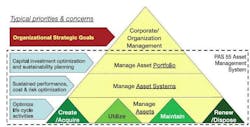Most of the time, when someone mentions asset management the discussion focuses on predictive and preventative maintenance to reduce or eliminate unexpected down time and associated lost production. It turns out, however, there’s much more to the concept.
As Maurice Henderson of Ventyx put it, “Asset management is not just about managing assets, it’s about deriving value and benefit from those assets.”
Back in 2003, the British Standards Institute began developing PAS 55, which defined good practices for the whole life cycle of assets as well as the optimized management of physical assets. At the Ventyx World conference in San Francisco this week, I learned that work is now underway on evolving PAS 55 into an international standard via ISO 55000.
According to Henderson, ISO 55000 will “define requirements for the good practice of an asset management management system.” You read that right: an asset management management system. In other words, ISO 55000 is not about managing assets directly, it’s about managing the process you use to mange assets in the most effective way.
The ISO 55000 site claims that the ISO 55000 family is “the first set of international standards for asset management.” The ISO 55000 standards comprises:
• ISO 55000 will specify the overview, concepts and terminology in asset management.
• ISO 55001 will define the requirements for a management system for asset management.
• ISO 55002 provides interpretation and implementation guidance for such a management system.
Explaining the origins of ISO 55000, Henderson said that as companies started adopting PAS 55, the U.K. submitted a request to ISO in 2009 to develop an asset management standard. The first meeting for ISO 55000 took place in March 2011. Henderson says the group expects to have the standard published by Feb 2014. He adds that, being an ISO standard, the framework will be familiar to those acquainted with the ISO 9000 (quality) and ISO 1400 (environmental) standards.
“Asset management is part of a total business management system,” says Henderson. “You can’t have an asset management system that lives in isolation. It’s connected to the operations, safety and financial departments.”
Leaders relevant to this article:


